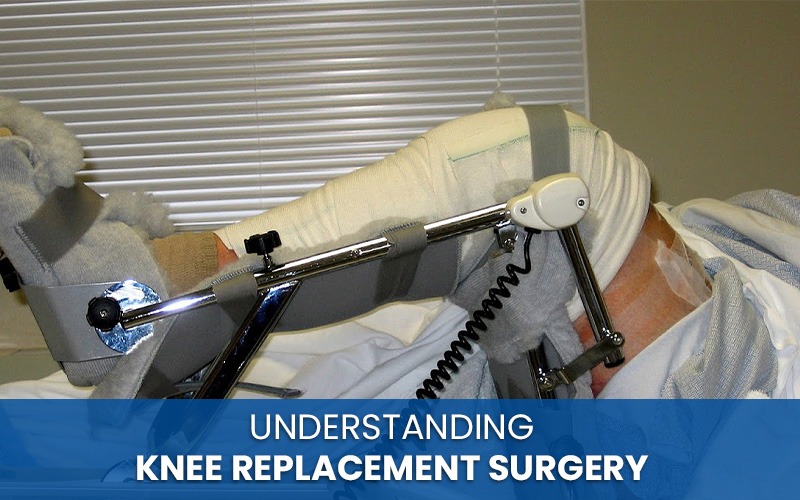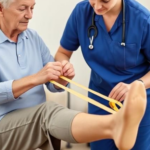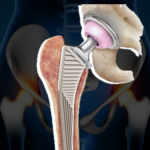
Knee replacement is a surgical procedure that involves removing the damaged or diseased parts of the knee joint and replacing them with artificial components. This procedure is usually recommended for individuals who experience chronic knee pain or have limited mobility due to arthritis, injury, or other conditions affecting the knee joint. Knee replacement surgery can help relieve pain, improve joint function, and enhance the quality of life for people with severe knee problems. The procedure is typically performed by an orthopaedic surgeon and involves several weeks of rehabilitation and recovery. The goal of knee replacement surgery is to relieve pain and improve function, allowing patients to return to their daily activities. In this blog, we will discuss the procedure, recovery, and risks associated with knee replacement surgery.
Procedure:
Before the surgery, the patient will undergo a thorough medical evaluation to assess their overall health and the extent of damage to the knee joint. The surgeon may also order imaging tests, such as X-rays, MRI, or CT scans, to help plan the surgery. On the day of surgery, the patient will be given anaesthesia to make them comfortable during the procedure. The surgeon will then make an incision on the front of the knee to access the joint. The damaged parts of the knee joint, including the cartilage and bone, will be removed and replaced with artificial components made of metal, plastic, or ceramic.
The artificial components will be attached to the bone using special bone cement or by using a technique called “press-fit,” which allows the bone to grow into the components over time. The surgeon will then close the incision using stitches or staples. The surgery usually takes between one to three hours to complete, and the patient will be monitored closely in the recovery room before being transferred to their hospital room.
Recovery:
- After knee replacement surgery, the patient will stay in the hospital for several days to monitor their recovery and manage any pain or discomfort. Physical therapy will begin immediately to help restore movement and strength to the knee joint.
- The patient will be given pain medication, either through an IV or orally, to manage any pain or discomfort after the surgery. They may also be given blood thinners to prevent blood clots from forming in the leg.
- The patient will need to use crutches or a walker to move around for the first few weeks after surgery. They will gradually be able to put more weight on the knee joint as it heals. Physical therapy will continue for several months to help improve strength and flexibility in the knee joint.
- It is important for the patient to follow their surgeon’s instructions carefully during the recovery period to ensure the best possible outcome. This may include attending physical therapy sessions, taking medications as prescribed, and avoiding certain activities that could put stress on the knee joint.
Risks:
As with any surgical procedure, there are risks associated with knee replacement surgery. Some of the most common risks include:
- Infection: The risk of infection after knee replacement surgery is low, but it can occur. Patients will be given antibiotics before and after surgery to help prevent infection.
- Blood clots: Blood clots can form in the leg after knee replacement surgery, which can be dangerous if they travel to the lungs. Patients will be given blood thinners to prevent blood clots from forming.
- Implant problems: In rare cases, the artificial components used in knee replacement surgery can become loose, wear out, or break. This may require additional surgery to replace the components.
- Nerve damage: During the surgery, there is a risk of damage to nerves near the knee joint, which can cause numbness or weakness in the leg.
- Allergic reactions: Some patients may have an allergic reaction to the materials used in the artificial components.
- Stiffness: Some patients may experience stiffness in the knee joint after surgery, which can make it difficult to move around. Physical therapy can help reduce stiffness and improve range of motion.
Conclusion:
Knee replacement surgery is a common and effective procedure for relieving pain and improving function in patients with damaged or diseased knee joints. The procedure involves removing damaged parts of the knee joint and replacing them with artificial components. Recovery from knee replacement surgery typically involves a few days of hospitalization, followed by several months of physical therapy to restore strength and mobility to the knee joint. While there are risks associated with knee replacement surgery, these risks can be minimized through careful preoperative planning, skilled surgical technique, and postoperative monitoring and care.
Patients who are considering knee replacement surgery should discuss the risks and benefits with their healthcare provider to determine if the procedure is appropriate for them. In general, knee replacement surgery is recommended for patients who have significant pain and loss of function in the knee joint that has not responded to other treatments. By undergoing knee replacement surgery, patients can experience significant improvement in their quality of life, including reduced pain, improved mobility, and the ability to return to their normal activities. With proper care and attention, most patients are able to enjoy the benefits of their new knee joint for many years.
Selecting a qualified surgeon with expertise is crucial for the operation. Dr Saurabh Giri, a highly skilled and accomplished partial knee replacement physician at Knee Replacement Surgeon Pune, has successfully completed numerous partial knee replacement surgeries.
In Pune, India, Dr Saurabh Giri is a well-known knee replacement physician. In addition to effectively treating many patients with knee pain and injuries, he has a great deal of experience conducting complex knee surgeries. He is renowned for his patient-centred philosophy and dedication to offering each of his patients individualised treatment. To ensure the greatest results for his patients, he believes in utilising the most recent methods and tools.
Do not delay in scheduling a consultation with Dr Saurabh Giri if you have knee discomfort or damage to learn more about the advantages of partial knee replacement surgery and to determine if it is the best course of action for you.




